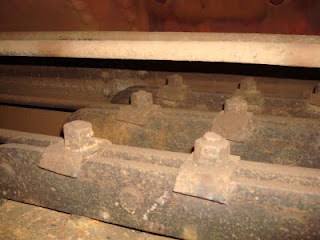
Portable Progress
Behind the scenes preparatory work regarding the two portable engines recently purchased by the museum continues. Prior to going to tender for their restoration, a full survey of each engine’s condition has to be prepared and compiled into a set of tendering documents and the beginnings of a Conservation Management Plan. This informs and guides the restoration and subsequent use and management of the engine and is something we produce for all such work. Those for Coffee Pot and Lewin run to tens of thousands of words!
All known information on the history is also recorded, as well as what is discovered. It informs the scope and extent of work carried out (balanced against the pragmatic need for safety and operational requirements) and so produces a detailed record of the engine/artifact. The value of these to curators and conservators cannot be understated!
For the portables, we contracted Vince Allen to remove the tubes, then Graham Morris to carry out a detailed boiler survey of each engine. This has been recorded in the CMP as well as enabling the tendering document to be created. This is a detailed 8 page review of the condition as currently understood, an inventory of each aspect of the engine and a detailed set of requirements regarding the restoration. Backed by an inspection by potential contractors, it should enable a realistic appraisal of the cost and scale of the work to be produced.
Below: The Clayton & Shuttleworth portable (13818/1874) – this view shows the girder stays on the firebox as well as the longitudinal stays above. The findings of Graham’s inspection reveal that a new inner firebox will be required (it has been boiled dry at some point during it’s South American life and as a result has ‘quilted’. This term reflects the fire-side appearance, where the stays have held steady but the plate around them has bulged, so creating the appearance of a quilt. There also appears to be a very bad repair made at some point and no fusible plug!!! The lack of the latter may explain the former of course…

Below: A Rack-saw has recently been obtained from Brandon (and it was originally installed near Brandon colliery on Sawmills Lane) and this has been brought, in pieces, to our store. It will be cleaned, conserved and prepared for eventual reassembly in a steam powered sawmill (driven by the Ruston – seen in the background!) at Beamish. It has been undercover all of its life and we are currently looking into its origins and true age.








Rather astounded given the Richard Hornsby engine left to gather dust at the farm and the criminally ‘bombed’ portable dumped at the colliery, more engines for beamish to flog then dump i presume….
Ian, I gather from your comments that you are interested in portable engines in particular?
The Ruston at Home Farm belongs to Tyne & Wear Museums and much as we would like to own and restore such an engine, we don’t and can’t. Whilst it would be nice to live in a dust free atmosphere, the engine is regularly inspected and cleaned seasonally. It is retained in secure and undercover accommodation as you will have seen.
The ‘criminally bombed’ portable is in fact a steam sterilising boiler and was exploded as an army exercise in the 1980s. Whilst not to everyone’s taste (including my own), it acts as a talking point and makes a very clear point regarding the power of steam.
Your final comment ‘more engines for Beamish to flog then dump I presume…’ is particularly provocative and I take great exception to this. Certainly in the past the Museum has had difficulty in maintaining the steam exhibits but it must be remembered that many of these were working on extensions of their working lives.
I fail to see how our now current practice of restoring, with considerable thoroughness, steam (and other) exhibits leads you to make such comments? They are profoundly inaccurate given the restoration of Coffee Pot No.1, the Savage Steam Gallopers, construction and ongoing operation of the three Waggonway engines, imminent completion of the restoration of Seaham No.18 (Lewin), ongoing commitment to hire and operation of the Y7 at Rowley Station, purchase, repatriation and commitment to completely overhaul ‘Dunrobin’, purchase of steam roller ‘Rambler’, basing of a working resident fleet of working road steam as well as the project to restore the Ruston Portable to as-new condition.
We have also constructed the ‘Steam Mule’ to assist the staff training, employed a steam engineer and apprentice to ensure we maintain the standards, re-boilered the colliery winding engine, recommissioned the jack engine and picking belt engine and have further detailed plans to restore and develop the working steam collection further. Not really a programme of work consistent with your comments I’m sure you will agree?
I would be interested to know the reasons behind your comments and whether they are based on recent experience of the Museum? Please feel free to contact me directly regarding this matter.
-Paul Jarman, Keeper of Transport